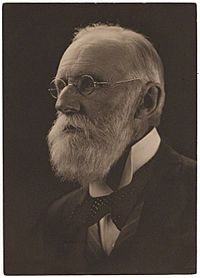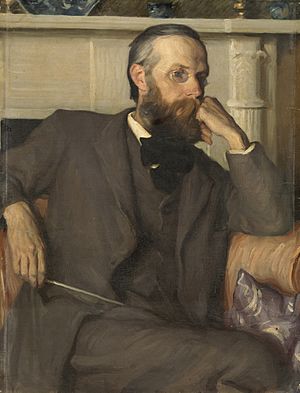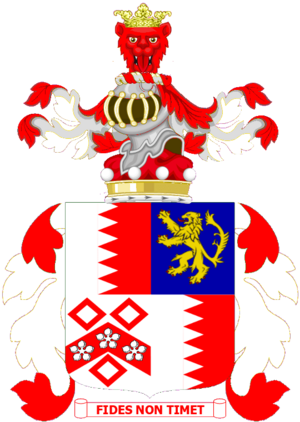Thomas Spring Rice, 2nd Baron Monteagle of Brandon facts for kids
Quick facts for kids
The Lord Monteagle of Brandon
KP DL
|
|
|---|---|
 |
|
| Personal details | |
| Born | 31 May 1849 Hither Green, London, England |
| Died | 24 December 1926 Limerick, Irish Free State |
| Nationality | British/Irish |
| Political party |
|
| Spouse |
Elizabeth Butcher
(m. 1875; died 1908) |
| Children | 3, including Mary and Thomas |
| Alma mater | Trinity College, Cambridge |
Thomas Spring Rice, 2nd Baron Monteagle of Brandon (born May 31, 1849 – died December 24, 1926) was an important Anglo-Irish politician and landowner. He played a big part in creating the Irish Dominion League, which wanted to keep Ireland united. He also helped develop cooperative farming in Ireland, which meant farmers worked together to share resources and sell their goods.
His Early Life and Family
Thomas Spring Rice was the oldest son of Stephen Spring Rice and Ellen Frere. He went to Harrow School and then Trinity College, Cambridge for his education. In 1866, he became the 2nd Baron Monteagle of Brandon after his grandfather passed away. His own father had died the year before.
Lord Monteagle became an active member of the House of Lords, which is part of the British Parliament. He spent a lot of time at his home, Mount Trenchard House in County Limerick, Ireland, where he managed his family's lands. He also owned property in London. In 1872, he even attended a meeting in support of women's right to vote in Ireland.
On October 26, 1875, Thomas Spring Rice married Elizabeth Butcher. They had three children together, and they made sure their children learned to speak Irish fluently.
- Stephen Edmond Spring Rice (1877-1900)
- Mary Spring Rice (1880–1924), who was an Irish nationalist activist.
- Thomas Spring Rice (1883–1934)
Sadly, his oldest son, Stephen, died before him. So, when Lord Monteagle passed away, his youngest son, Thomas, inherited his title. After Thomas also died without children in 1934, the title went to Thomas's uncle, Francis Spring Rice. Lord Monteagle was also a cousin of Sir Cecil Spring Rice, who was the British Ambassador to the United States.
His Political Journey
Like his grandfather, Lord Monteagle was a unionist when he joined the House of Lords. This meant he believed Ireland should remain part of the United Kingdom. He started out as a member of the Liberal Party. In 1885, he wrote a paper about their policies for Ireland.
However, the next year, he became a Liberal Unionist. This was because he worried that Gladstone's plan for Home Rule (giving Ireland more control over its own affairs) would lead to Ireland becoming completely independent. Because of this, Lord Monteagle joined other unionist peers in the Irish Unionist Alliance. He became a key leader among moderate unionists in Southern Ireland.
Living in Ireland, he saw how the political situation got worse in the 1890s. He slowly realized that unionists needed to find a way to compromise with Irish nationalists to keep the United Kingdom together.
In 1911, he helped start the Proportional Representation Society of Ireland and later became its president. He believed that proportional representation (a fairer way of voting) would help prevent arguments between unionists and nationalists if Ireland governed itself.
In 1917, he helped organize the Irish Convention. He used his connections to make sure that Sinn Féin, a nationalist party, was represented, even though their leaders refused to attend. That same year, he publicly said he was a moderate who still believed in the Union but understood it wasn't working for most Irish people.
He really wanted Ireland to stay united and not be divided. In 1919, he left the Unionist Alliance and joined the Irish Dominion League. This group was led by his good friend, Sir Horace Plunkett. Lord Monteagle became the chairman of the League's London branch. He tried to convince David Lloyd George's government to give a united Ireland "dominion status." This meant Ireland would be like Canada or Australia, having its own government but still being part of the British Empire.
In June 1920, he set up meetings between the British government and the nationalist leader George Gavan Duffy. A month later, he proposed his own "Dominion of Ireland Bill" in the House of Lords. This was happening at the same time the government was discussing its own plan for Ireland. Monteagle's bill would have given a united Ireland a lot of self-rule, managing all its own matters. However, he thought foreign affairs and defense should still be handled by the British government. His bill was defeated on July 1, 1920.
He also upset some unionists in Ireland in February 1920. He wrote a letter to The Times newspaper, asking for an end to the arrest and imprisonment of recently elected Sinn Féin politicians without trial.
Important Roles and Awards
Lord Monteagle received a special honor on February 9, 1885, when he was made a Knight of the Order of St Patrick. His special flag, called an armorial banner, hangs in St Patrick's Hall at Dublin Castle alongside those of other knights.
He also served as the Deputy Lieutenant for the County of Limerick. He was a founder of the Irish Agricultural Organisation Society with Sir Horace Plunkett, and later became its president. He strongly supported the idea of cooperative economics, where farmers work together for their shared benefit. From 1882 to 1884, he was the president of the Statistical and Social Inquiry Society of Ireland.



